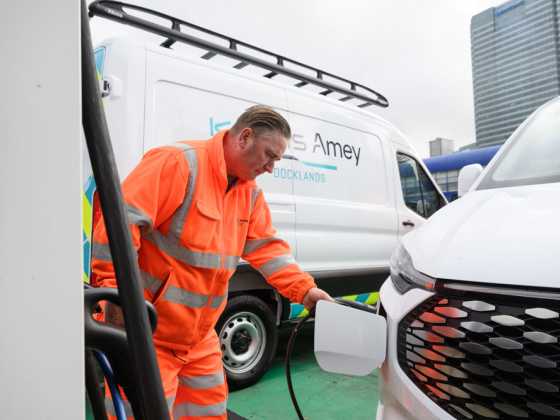Greening business travel and commutes

With policy measures designed to reduce the reliance on privately owned ICE vehicles, such as Clean Air Zones, the expansion of the Ultra Low Emission Zone in London, and workplace parking levies, businesses should reassess how staff commute and conduct their business travel, writes James Lancaster, Chair of the Urban Mobility Partnership
In 2021, the Department for Transport published its seminal document on how they plan to decarbonise transport over the coming years: the Transport Decarbonisation Plan. The UK also hosted COP26 in Glasgow and both actions committed to significant targets for carbon reduction. Progress has already been made over the last 12 months on some of the ambitions of the Transport Decarbonisation Plan, with the first part of the Local Authority Toolkit published, the consultation on the Mobility as a Service: Code of Practice and the launch of the Commute Zero programme. However, the next steps are key. It is still the case that for many people the default mode remains the private car and this is the most significant challenge in reducing emissions and congestion. The transition to electric vehicles is progressing but we know just transitioning to private EVs from privately owned internal combustion engines (ICE) vehicles will not solve the challenges of reducing congestion and reaching net zero.
We continue to see policy measures designed with the intention to reduce the reliance on the privately owned ICEs, such as Clean Air Zones, the expansion of the Ultra Low Emission Zone in London, workplace parking levies and sustainable transport hierarchies. The importance and relevance of which may be increased as the UK brings in new air quality targets and as the Department for Transport publishes its guidance for local authorities on the development of renewed Local Transport Plans.
But government also needs to be conscious of ordinary people and businesses. Whilst across the UK we see increased awareness of environmental issues, it is important that policy over the coming years is not just top-down driven, but places consumers needs and desires right at the heart of them.
Behavioural change is vital to deliver our policy objectives and for this to happen we must bring people along for the journey. Ultimately businesses and consumers will require access to forms of transport that are not the private car and be empowered to choose the mode that is right for their journey. Key to achieving this is accessibility.
Providers, innovators and policy makers need to be pulling the right levers which ensure that new forms of mobility and multi-modal journeys deliver the same convenience that consumers have come accustomed to with having access to the private car.
Changing business travel
Businesses can play a role in supporting these ambitions by changing the way they conduct business travel and encouraging their employees to make use of alternative forms of transport for commuting. First and foremost, it is clear that business travel and commuting are intrinsically linked. If an employee is going to need their car for business travel, it is inevitable that they will use this mode for their commute.
Reducing grey fleet – the use of a car or van that is owned by an employee – for E business travel, should be an ambition of all organisations and can have a significant impact on reducing an organisation’s environmental footprint. There are a number of things organisations can do to reduce grey fleet, but firstly the requirement to have access to a private vehicle can be removed from employment contracts.
Secondly, employees need to work with operators to ensure that schemes are in place for their employees to make use of, such as car clubs, bike share and e-scooters, and access to public transport networks. This can even be expanded further by working with operators to develop mobility-as-a-service solutions, specifically for a business’s employees, which can provide access to a variety of modes in one place and can identify the most suitable modes for journeys.
Better transport
Once people see the variety of modes available to them and understand that there are alternatives, this can encourage them to change the way they commute to and from their place.
However, the onus cannot just be on consumers and employers. Government at all levels can support this. Developing a comprehensive network of transport options through Local Transport Plans can help people to drive behavioural change. The Department for Transport are already working on guidance for commuting through the Commute Zero Programme, but to make real change and to really incentivise a shift in mindset, it is vital there is cross-departmental work that makes alternatives to the private car a viable option. For example, in France, they have through legislative changes made it possible for private business to provide their employees with a tax-free mobility allowance for use on locally available sustainable transport.
Similarly, rules around Benefit-in-Kind Tax require updating to allow flexibility for sustainable travel innovations. One of the ways this currently inhibits access to sustainable forms is by limiting access to shared vehicles. If businesses make car club or carpool vehicles available, not only for business travel but also for commuting, benefit in kind is incurred and effectively penalises these forms of mobility. Further incentivise could be made through the tax system by putting in tax breaks for making sustainable choices for commuting, such as committing to a salary sacrifice scheme for annual bus or rail season tickets. These are also measures which can help support consumers at a time when pressure is on to see how the government will respond to the cost-of-living crisis.
Collaboration
The key to all these elements is collaboration. Businesses must work with their employees, and operators and government need to support both consumers to make the behavioural change necessary and support operators in facilitating it. Infrastructure, both physical and digital, will ultimately be vital and this requires transport operators and local authorities to work together. The development of concepts like mobility hubs and mobility as a service can deliver the convenience and accessibility required for people to make use of shared and public transport options, and the public and private sector must work together on developing these networks so that consumers and businesses can take advantage of easily accessible and shared multi-modal journeys.






